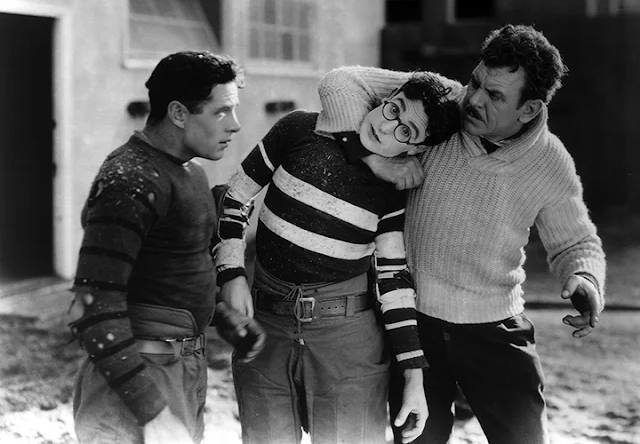 |
| Ann Christy and Harold Lloyd in Speedy |
Ted Wilde, the director of Speedy, was nominated for an Academy Award in the very first year of what would come to be called the Oscars. But the category in which he was nominated, best director of a comedy picture, was short-lived: It vanished in the second year of the awards. The award went to Lewis Milestone for Two Arabian Knights (1927), which isn't nearly as funny a movie as Speedy, but the fact of having a separate award for comedy movies is suggestive of the power that comic films had in the silent era. Today, more people have seen the films of Charles Chaplin, Buster Keaton, and Harold Lloyd than have seen the classics of "serious" silent film, largely because a pratfall doesn't need title cards to explain itself. Speedy was Lloyd's last silent feature. Chaplin persisted in making silent comedies up through Modern Times in 1936, but Keaton and Lloyd ventured into sound -- with unsatisfactory results. So Speedy can be seen as a valedictory to the era, and a good one. The "Harold" of the movie, Harold "Speedy" Swift, is a brasher persona than the more milquetoast characters also named Harold in Safety Last! (1923), The Freshman (1925), and The Kid Brother (1927). He already has a girl, the pretty Jane Dillon (Ann Christy), who lives with her grandfather, called Pop (Bert Woodruff). He's a little feckless -- he can't seem to hold a job -- but good at heart, and when Pop Dillon's livelihood is threatened, he gives it his all. Pop owns the last horse-drawn streetcar in New York, and the forces of progress want to buy him out, car, tracks, and all. They're willing to stop at nothing until Harold marshals the neighborhood into fighting back, if only to get the price Pop deserves. But the plot, such as it is, takes up only the latter part of the film. The rest is a series of set pieces -- Harold as a soda jerk, Harold as a cab driver, Harold and Jane go to Coney Island -- that are excuses for a series of ever more elaborate gags. The one extraneous thing we know about Harold is that he's a huge fan of the New York Yankees, which has nothing to do with the streetcar plot, but is really a setup for him to wind up with Babe Ruth in the back seat of his cab, and for Ruth to get bounced around, and to mug hilariously, as Harold drives him pell-mell through the street of New York to get him to a Yankees game on time. Lou Gehrig also has a blink-and-you'll-miss-it walk-on cameo. I blinked, but I don't think I'd recognize Gehrig unless he looked like Gary Cooper. Though it lacks the tight structure of the plots for the earlier films, Speedy justifies its loosey-goosey narrative by becoming a tribute to the organized chaos that is New York City in 1928.



















